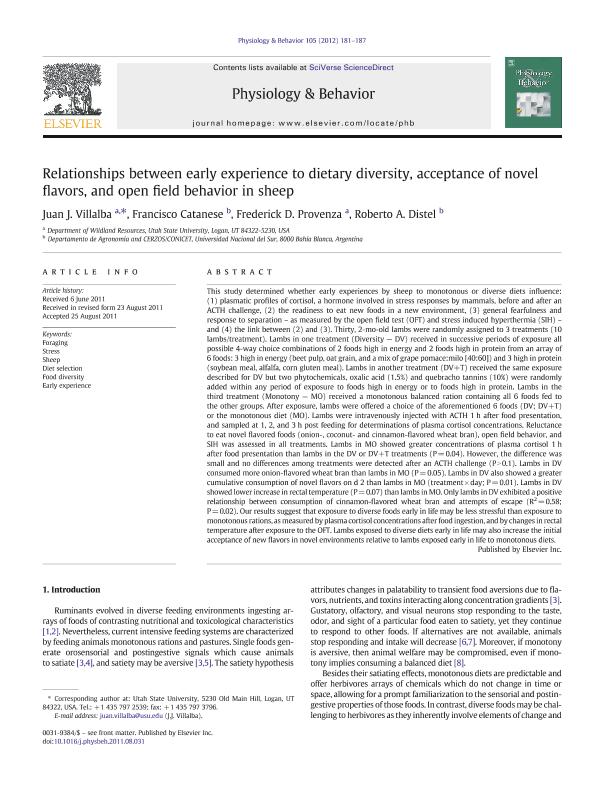Artículo
Relationships between early experience to dietary diversity, acceptance of novel flavors, and open field behavior in sheep
Fecha de publicación:
01/2012
Editorial:
Elsevier
Revista:
Physiology And Behavior
ISSN:
0031-9384
Idioma:
Inglés
Tipo de recurso:
Artículo publicado
Clasificación temática:
Resumen
This study determined whether early experiences by sheep to monotonous or diverse diets influence: (1) plasmatic profiles of cortisol, a hormone involved in stress responses by mammals, before and after an ACTH challenge, (2) the readiness to eat new foods in a new environment, (3) general fearfulness and response to separation - as measured by the open field test (OFT) and stress induced hyperthermia (SIH) - and (4) the link between (2) and (3). Thirty, 2-mo-old lambs were randomly assigned to 3 treatments (10 lambs/treatment). Lambs in one treatment (Diversity - DV) received in successive periods of exposure all possible 4-way choice combinations of 2 foods high in energy and 2 foods high in protein from an array of 6 foods: 3 high in energy (beet pulp, oat grain, and a mix of grape pomace:milo [40:60]) and 3 high in protein (soybean meal, alfalfa, corn gluten meal). Lambs in another treatment (DV+T) received the same exposure described for DV but two phytochemicals, oxalic acid (1.5%) and quebracho tannins (10%) were randomly added within any period of exposure to foods high in energy or to foods high in protein. Lambs in the third treatment (Monotony - MO) received a monotonous balanced ration containing all 6 foods fed to the other groups. After exposure, lambs were offered a choice of the aforementioned 6 foods (DV; DV+T) or the monotonous diet (MO). Lambs were intravenously injected with ACTH 1h after food presentation, and sampled at 1, 2, and 3h post feeding for determinations of plasma cortisol concentrations. Reluctance to eat novel flavored foods (onion-, coconut- and cinnamon-flavored wheat bran), open field behavior, and SIH was assessed in all treatments. Lambs in MO showed greater concentrations of plasma cortisol 1h after food presentation than lambs in the DV or DV+T treatments (P=0.04). However, the difference was small and no differences among treatments were detected after an ACTH challenge (P>0.1). Lambs in DV consumed more onion-flavored wheat bran than lambs in MO (P=0.05). Lambs in DV also showed a greater cumulative consumption of novel flavors on d 2 than lambs in MO (treatment×day; P=0.01). Lambs in DV showed lower increase in rectal temperature (P=0.07) than lambs in MO. Only lambs in DV exhibited a positive relationship between consumption of cinnamon-flavored wheat bran and attempts of escape (R 2=0.58; P=0.02). Our results suggest that exposure to diverse foods early in life may be less stressful than exposure to monotonous rations, as measured by plasma cortisol concentrations after food ingestion, and by changes in rectal temperature after exposure to the OFT. Lambs exposed to diverse diets early in life may also increase the initial acceptance of new flavors in novel environments relative to lambs exposed early in life to monotonous diets.
Palabras clave:
Diet Selection
,
Early Experience
,
Food Diversity
,
Foraging
,
Sheep
,
Stress
Archivos asociados
Licencia
Identificadores
Colecciones
Articulos(CERZOS)
Articulos de CENTRO REC.NAT.RENOVABLES DE ZONA SEMIARIDA(I)
Articulos de CENTRO REC.NAT.RENOVABLES DE ZONA SEMIARIDA(I)
Citación
Villalba, Juan J.; Catanese, Francisco Hernan; Provenza, Frederick D.; Distel, Roberto Alejandro; Relationships between early experience to dietary diversity, acceptance of novel flavors, and open field behavior in sheep; Elsevier; Physiology And Behavior; 105; 2; 1-2012; 181-187
Compartir
Altmétricas




